Leadership and Employee Motivation
VerifiedAdded on 2020/02/05
|14
|3968
|75
AI Summary
This assignment delves into the crucial relationship between leadership, motivation, and employee performance. It emphasizes the influence of these factors on team functioning and productivity. The text examines various theories and concepts related to intrinsic and extrinsic motivation, highlighting practical strategies for leaders to enhance employee morale and job satisfaction. Understanding the dynamics of motivation and leadership is essential for creating a successful and fulfilling work environment.
Contribute Materials
Your contribution can guide someone’s learning journey. Share your
documents today.

ORGANISATIONS AND
BEHAVIOUR
BEHAVIOUR
Secure Best Marks with AI Grader
Need help grading? Try our AI Grader for instant feedback on your assignments.
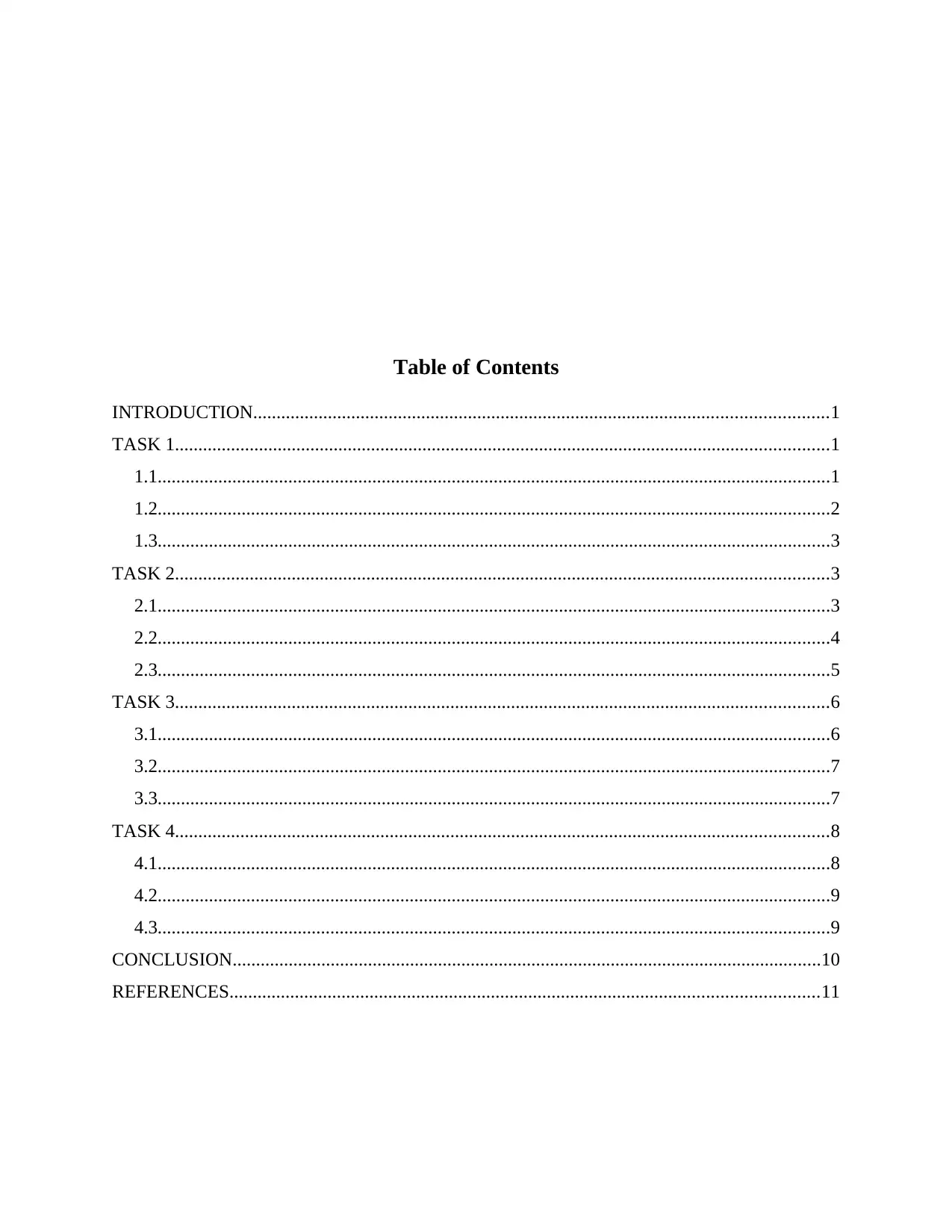
Table of Contents
INTRODUCTION...........................................................................................................................1
TASK 1............................................................................................................................................1
1.1................................................................................................................................................1
1.2................................................................................................................................................2
1.3................................................................................................................................................3
TASK 2............................................................................................................................................3
2.1................................................................................................................................................3
2.2................................................................................................................................................4
2.3................................................................................................................................................5
TASK 3............................................................................................................................................6
3.1................................................................................................................................................6
3.2................................................................................................................................................7
3.3................................................................................................................................................7
TASK 4............................................................................................................................................8
4.1................................................................................................................................................8
4.2................................................................................................................................................9
4.3................................................................................................................................................9
CONCLUSION..............................................................................................................................10
REFERENCES..............................................................................................................................11
INTRODUCTION...........................................................................................................................1
TASK 1............................................................................................................................................1
1.1................................................................................................................................................1
1.2................................................................................................................................................2
1.3................................................................................................................................................3
TASK 2............................................................................................................................................3
2.1................................................................................................................................................3
2.2................................................................................................................................................4
2.3................................................................................................................................................5
TASK 3............................................................................................................................................6
3.1................................................................................................................................................6
3.2................................................................................................................................................7
3.3................................................................................................................................................7
TASK 4............................................................................................................................................8
4.1................................................................................................................................................8
4.2................................................................................................................................................9
4.3................................................................................................................................................9
CONCLUSION..............................................................................................................................10
REFERENCES..............................................................................................................................11

INTRODUCTION
Employees are the key persons of the organization, their work and skills assist business
unit in accomplishing its goal and objective. Optimistic attitude of workers support in enhancing
the working efficiency of the enterprise. Organization behaviour is concern with the operations
of an entity which impacts on the performance of the employees and corporation as well. It can
be termed as management and prediction of human behaviour which supports to encourage
people in the workplace (Saaty and Kearns, 2014). For the present report GlaxoSmithKlinc Plc
(GSK) is being taken into account. It is engaged in heath care service which discover,
manufacture and market a pharmaceutical products. Current assignment will focus on
relationship between organizational structure and culture. Impact of different leadership styles
will be illustrated in this study. It will cover the various factors which promote the development
of effective team working.
TASK 1
1.1
Hierarchical distribution of roles and responsibilities can be termed as organizational
structure. It depends upon size, scope and objective of the firm. Companies generally follow
three types of structures; Hierarchical, geographic, horizontal and matrix. In tall structure power
is in hand of higher authorities and top management takes all decisions whereas in flat structure
firms involve its staff members in decision making process and take their suggestions in each
activity. Matrix structure is differed from both above these, as in this enterprises hire skilled
person those who have knowledge about particular section (Gartner, Carter and Hills, 2016). To
compare the structure of GSK, PFIZER INC. is being taken into account. It is the competitor
brand of the cited firm.
PFIZER INC GSK
It follows the tall organizational structure.
There are several layers are present in the
system.
It follows the flat structure, there is limited
one or two layers are present.
In this structure long chain of command is
present, in each layer there is managerial
layer who control over the employees.
Short command chain is present, manager
involve its executives in decision making
process
Employees are the key persons of the organization, their work and skills assist business
unit in accomplishing its goal and objective. Optimistic attitude of workers support in enhancing
the working efficiency of the enterprise. Organization behaviour is concern with the operations
of an entity which impacts on the performance of the employees and corporation as well. It can
be termed as management and prediction of human behaviour which supports to encourage
people in the workplace (Saaty and Kearns, 2014). For the present report GlaxoSmithKlinc Plc
(GSK) is being taken into account. It is engaged in heath care service which discover,
manufacture and market a pharmaceutical products. Current assignment will focus on
relationship between organizational structure and culture. Impact of different leadership styles
will be illustrated in this study. It will cover the various factors which promote the development
of effective team working.
TASK 1
1.1
Hierarchical distribution of roles and responsibilities can be termed as organizational
structure. It depends upon size, scope and objective of the firm. Companies generally follow
three types of structures; Hierarchical, geographic, horizontal and matrix. In tall structure power
is in hand of higher authorities and top management takes all decisions whereas in flat structure
firms involve its staff members in decision making process and take their suggestions in each
activity. Matrix structure is differed from both above these, as in this enterprises hire skilled
person those who have knowledge about particular section (Gartner, Carter and Hills, 2016). To
compare the structure of GSK, PFIZER INC. is being taken into account. It is the competitor
brand of the cited firm.
PFIZER INC GSK
It follows the tall organizational structure.
There are several layers are present in the
system.
It follows the flat structure, there is limited
one or two layers are present.
In this structure long chain of command is
present, in each layer there is managerial
layer who control over the employees.
Short command chain is present, manager
involve its executives in decision making
process

In this structure rules and regulation play a
important role, no one can breach any
regulation of the company.
Staff members have rights to take their own
decisions and they can work according to
their norms. It encourages innovation in the
workplace.
In this structure PFIZER INC concentrate
more on its employees and motivate them by
giving rewards so that they perform better in
the workplace (Wilensky, 2015).
less supervision is here, management have
nurturing nature which helps in making
flexible working environment.
Culture
Values, beliefs, ethics of the organization are known as culture. Optimistic culture
supports in creating health working environment in the workplace. Charles Handy states the four
main types of cultures; Power, role, task and appropriate culture. GSK follows the task culture,
all members work together and they have common interest. They have strong relationship with
each other. Flexibility is included in its culture, company provides open space layout in which
all workers can discuss their issue with each other easily. PFIZER INC follows power culture in
which top management have power to take any decision (Vaccaro and et.al, 2012). Employees
cannot share their feeling even they do not have liberty to say anything.
1.2
Relationship between organization structure and culture impact on the performance of
GSK to great extent. Structure defines the job responsibilities whereas culture explains the
working behaviour of workers. As GSK follows the flat structure it gives authorities to its
employees. It enhances their satisfaction and makes them loyal towards the brand. Flexible
working hours, reward system makes them positive towards the firm. GSK values such as
integrity, transparency supports the organization in working well. It focuses on consumer
satisfaction and for that it focuses more on employees so that they treat well to customers. This
culture encourage them to do well and they put their best efforts to accomplishing the goal of the
company (Piaget, 2013). As structure of GSK is quit simple thus, employees are highly
motivated and use their innovative ideas for improving working efficiency of the firm. It makes
them positive thus, they perform well and by this way revenue of the organization get increased.
Structure of the entity helps to create healthy working environment and it increases morale of the
important role, no one can breach any
regulation of the company.
Staff members have rights to take their own
decisions and they can work according to
their norms. It encourages innovation in the
workplace.
In this structure PFIZER INC concentrate
more on its employees and motivate them by
giving rewards so that they perform better in
the workplace (Wilensky, 2015).
less supervision is here, management have
nurturing nature which helps in making
flexible working environment.
Culture
Values, beliefs, ethics of the organization are known as culture. Optimistic culture
supports in creating health working environment in the workplace. Charles Handy states the four
main types of cultures; Power, role, task and appropriate culture. GSK follows the task culture,
all members work together and they have common interest. They have strong relationship with
each other. Flexibility is included in its culture, company provides open space layout in which
all workers can discuss their issue with each other easily. PFIZER INC follows power culture in
which top management have power to take any decision (Vaccaro and et.al, 2012). Employees
cannot share their feeling even they do not have liberty to say anything.
1.2
Relationship between organization structure and culture impact on the performance of
GSK to great extent. Structure defines the job responsibilities whereas culture explains the
working behaviour of workers. As GSK follows the flat structure it gives authorities to its
employees. It enhances their satisfaction and makes them loyal towards the brand. Flexible
working hours, reward system makes them positive towards the firm. GSK values such as
integrity, transparency supports the organization in working well. It focuses on consumer
satisfaction and for that it focuses more on employees so that they treat well to customers. This
culture encourage them to do well and they put their best efforts to accomplishing the goal of the
company (Piaget, 2013). As structure of GSK is quit simple thus, employees are highly
motivated and use their innovative ideas for improving working efficiency of the firm. It makes
them positive thus, they perform well and by this way revenue of the organization get increased.
Structure of the entity helps to create healthy working environment and it increases morale of the
Secure Best Marks with AI Grader
Need help grading? Try our AI Grader for instant feedback on your assignments.
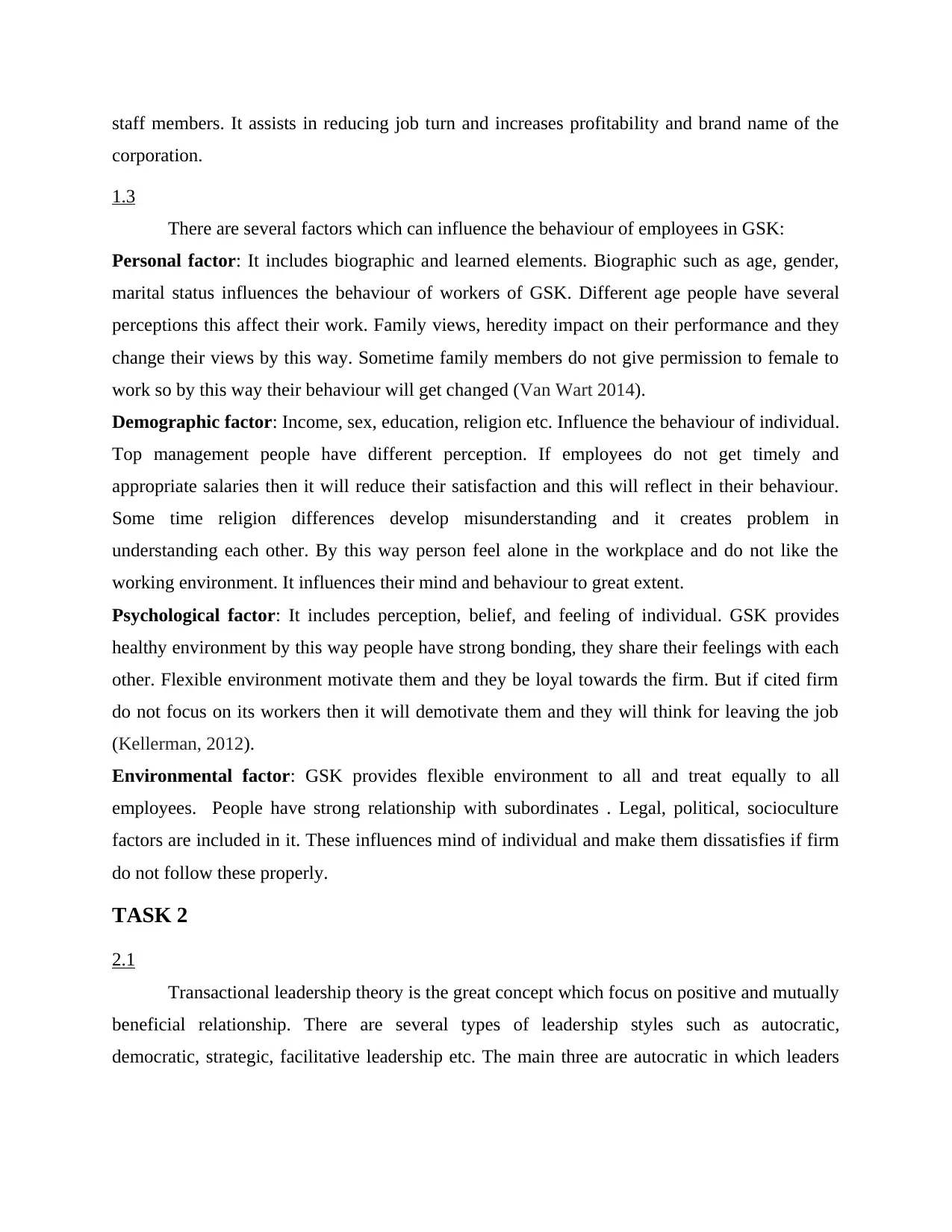
staff members. It assists in reducing job turn and increases profitability and brand name of the
corporation.
1.3
There are several factors which can influence the behaviour of employees in GSK:
Personal factor: It includes biographic and learned elements. Biographic such as age, gender,
marital status influences the behaviour of workers of GSK. Different age people have several
perceptions this affect their work. Family views, heredity impact on their performance and they
change their views by this way. Sometime family members do not give permission to female to
work so by this way their behaviour will get changed (Van Wart 2014).
Demographic factor: Income, sex, education, religion etc. Influence the behaviour of individual.
Top management people have different perception. If employees do not get timely and
appropriate salaries then it will reduce their satisfaction and this will reflect in their behaviour.
Some time religion differences develop misunderstanding and it creates problem in
understanding each other. By this way person feel alone in the workplace and do not like the
working environment. It influences their mind and behaviour to great extent.
Psychological factor: It includes perception, belief, and feeling of individual. GSK provides
healthy environment by this way people have strong bonding, they share their feelings with each
other. Flexible environment motivate them and they be loyal towards the firm. But if cited firm
do not focus on its workers then it will demotivate them and they will think for leaving the job
(Kellerman, 2012).
Environmental factor: GSK provides flexible environment to all and treat equally to all
employees. People have strong relationship with subordinates . Legal, political, socioculture
factors are included in it. These influences mind of individual and make them dissatisfies if firm
do not follow these properly.
TASK 2
2.1
Transactional leadership theory is the great concept which focus on positive and mutually
beneficial relationship. There are several types of leadership styles such as autocratic,
democratic, strategic, facilitative leadership etc. The main three are autocratic in which leaders
corporation.
1.3
There are several factors which can influence the behaviour of employees in GSK:
Personal factor: It includes biographic and learned elements. Biographic such as age, gender,
marital status influences the behaviour of workers of GSK. Different age people have several
perceptions this affect their work. Family views, heredity impact on their performance and they
change their views by this way. Sometime family members do not give permission to female to
work so by this way their behaviour will get changed (Van Wart 2014).
Demographic factor: Income, sex, education, religion etc. Influence the behaviour of individual.
Top management people have different perception. If employees do not get timely and
appropriate salaries then it will reduce their satisfaction and this will reflect in their behaviour.
Some time religion differences develop misunderstanding and it creates problem in
understanding each other. By this way person feel alone in the workplace and do not like the
working environment. It influences their mind and behaviour to great extent.
Psychological factor: It includes perception, belief, and feeling of individual. GSK provides
healthy environment by this way people have strong bonding, they share their feelings with each
other. Flexible environment motivate them and they be loyal towards the firm. But if cited firm
do not focus on its workers then it will demotivate them and they will think for leaving the job
(Kellerman, 2012).
Environmental factor: GSK provides flexible environment to all and treat equally to all
employees. People have strong relationship with subordinates . Legal, political, socioculture
factors are included in it. These influences mind of individual and make them dissatisfies if firm
do not follow these properly.
TASK 2
2.1
Transactional leadership theory is the great concept which focus on positive and mutually
beneficial relationship. There are several types of leadership styles such as autocratic,
democratic, strategic, facilitative leadership etc. The main three are autocratic in which leaders
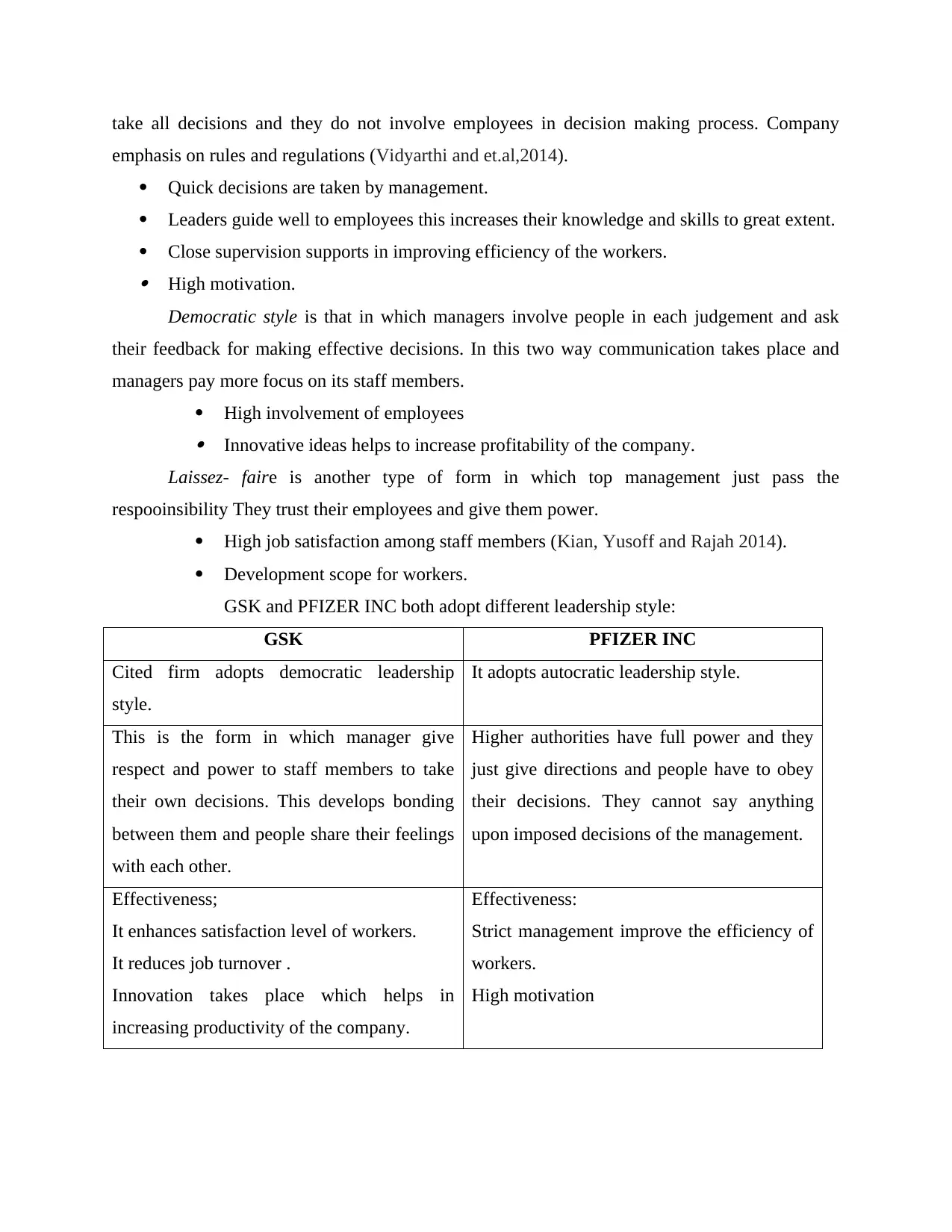
take all decisions and they do not involve employees in decision making process. Company
emphasis on rules and regulations (Vidyarthi and et.al,2014).
Quick decisions are taken by management.
Leaders guide well to employees this increases their knowledge and skills to great extent.
Close supervision supports in improving efficiency of the workers. High motivation.
Democratic style is that in which managers involve people in each judgement and ask
their feedback for making effective decisions. In this two way communication takes place and
managers pay more focus on its staff members.
High involvement of employees
Innovative ideas helps to increase profitability of the company.
Laissez- faire is another type of form in which top management just pass the
respooinsibility They trust their employees and give them power.
High job satisfaction among staff members (Kian, Yusoff and Rajah 2014).
Development scope for workers.
GSK and PFIZER INC both adopt different leadership style:
GSK PFIZER INC
Cited firm adopts democratic leadership
style.
It adopts autocratic leadership style.
This is the form in which manager give
respect and power to staff members to take
their own decisions. This develops bonding
between them and people share their feelings
with each other.
Higher authorities have full power and they
just give directions and people have to obey
their decisions. They cannot say anything
upon imposed decisions of the management.
Effectiveness;
It enhances satisfaction level of workers.
It reduces job turnover .
Innovation takes place which helps in
increasing productivity of the company.
Effectiveness:
Strict management improve the efficiency of
workers.
High motivation
emphasis on rules and regulations (Vidyarthi and et.al,2014).
Quick decisions are taken by management.
Leaders guide well to employees this increases their knowledge and skills to great extent.
Close supervision supports in improving efficiency of the workers. High motivation.
Democratic style is that in which managers involve people in each judgement and ask
their feedback for making effective decisions. In this two way communication takes place and
managers pay more focus on its staff members.
High involvement of employees
Innovative ideas helps to increase profitability of the company.
Laissez- faire is another type of form in which top management just pass the
respooinsibility They trust their employees and give them power.
High job satisfaction among staff members (Kian, Yusoff and Rajah 2014).
Development scope for workers.
GSK and PFIZER INC both adopt different leadership style:
GSK PFIZER INC
Cited firm adopts democratic leadership
style.
It adopts autocratic leadership style.
This is the form in which manager give
respect and power to staff members to take
their own decisions. This develops bonding
between them and people share their feelings
with each other.
Higher authorities have full power and they
just give directions and people have to obey
their decisions. They cannot say anything
upon imposed decisions of the management.
Effectiveness;
It enhances satisfaction level of workers.
It reduces job turnover .
Innovation takes place which helps in
increasing productivity of the company.
Effectiveness:
Strict management improve the efficiency of
workers.
High motivation
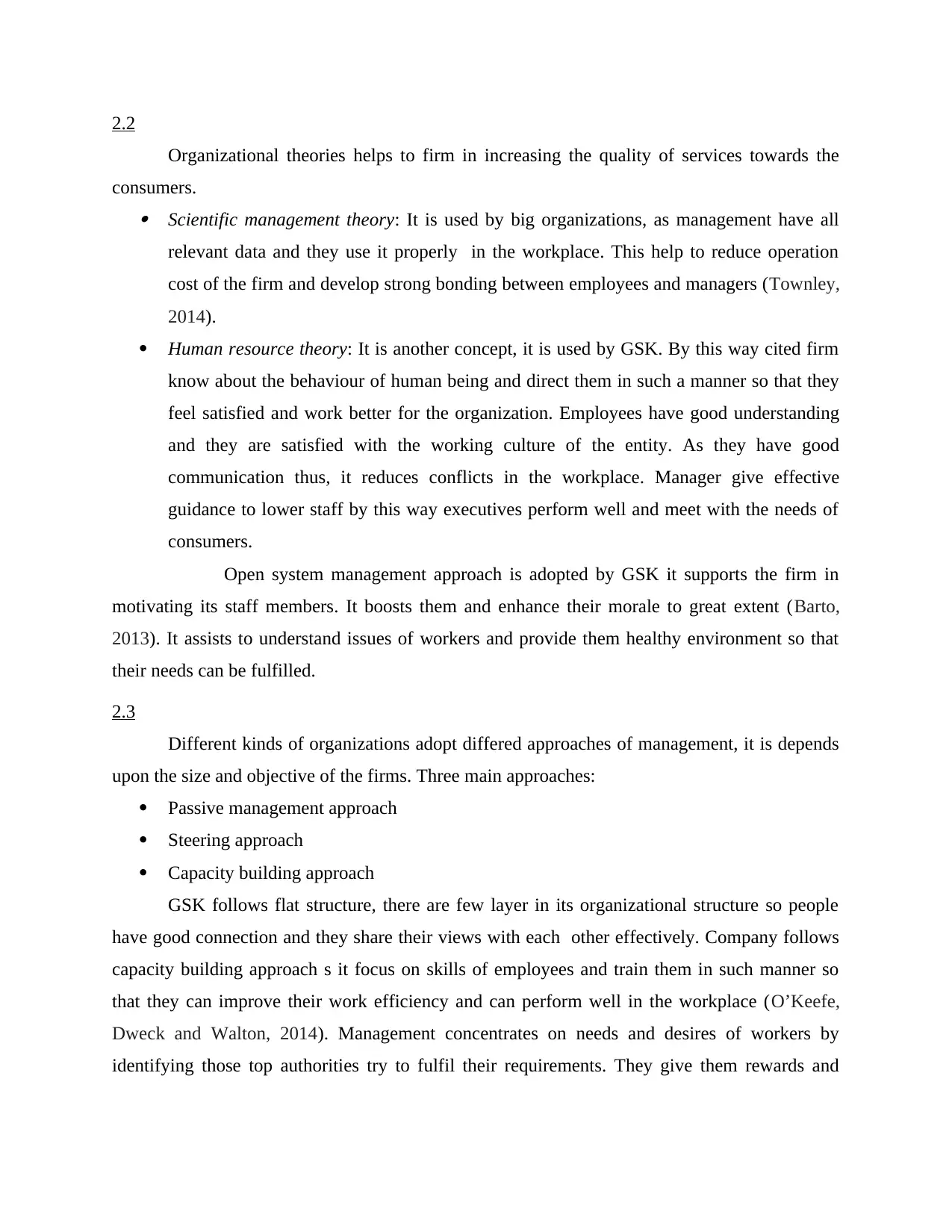
2.2
Organizational theories helps to firm in increasing the quality of services towards the
consumers. Scientific management theory: It is used by big organizations, as management have all
relevant data and they use it properly in the workplace. This help to reduce operation
cost of the firm and develop strong bonding between employees and managers (Townley,
2014).
Human resource theory: It is another concept, it is used by GSK. By this way cited firm
know about the behaviour of human being and direct them in such a manner so that they
feel satisfied and work better for the organization. Employees have good understanding
and they are satisfied with the working culture of the entity. As they have good
communication thus, it reduces conflicts in the workplace. Manager give effective
guidance to lower staff by this way executives perform well and meet with the needs of
consumers.
Open system management approach is adopted by GSK it supports the firm in
motivating its staff members. It boosts them and enhance their morale to great extent (Barto,
2013). It assists to understand issues of workers and provide them healthy environment so that
their needs can be fulfilled.
2.3
Different kinds of organizations adopt differed approaches of management, it is depends
upon the size and objective of the firms. Three main approaches:
Passive management approach
Steering approach
Capacity building approach
GSK follows flat structure, there are few layer in its organizational structure so people
have good connection and they share their views with each other effectively. Company follows
capacity building approach s it focus on skills of employees and train them in such manner so
that they can improve their work efficiency and can perform well in the workplace (O’Keefe,
Dweck and Walton, 2014). Management concentrates on needs and desires of workers by
identifying those top authorities try to fulfil their requirements. They give them rewards and
Organizational theories helps to firm in increasing the quality of services towards the
consumers. Scientific management theory: It is used by big organizations, as management have all
relevant data and they use it properly in the workplace. This help to reduce operation
cost of the firm and develop strong bonding between employees and managers (Townley,
2014).
Human resource theory: It is another concept, it is used by GSK. By this way cited firm
know about the behaviour of human being and direct them in such a manner so that they
feel satisfied and work better for the organization. Employees have good understanding
and they are satisfied with the working culture of the entity. As they have good
communication thus, it reduces conflicts in the workplace. Manager give effective
guidance to lower staff by this way executives perform well and meet with the needs of
consumers.
Open system management approach is adopted by GSK it supports the firm in
motivating its staff members. It boosts them and enhance their morale to great extent (Barto,
2013). It assists to understand issues of workers and provide them healthy environment so that
their needs can be fulfilled.
2.3
Different kinds of organizations adopt differed approaches of management, it is depends
upon the size and objective of the firms. Three main approaches:
Passive management approach
Steering approach
Capacity building approach
GSK follows flat structure, there are few layer in its organizational structure so people
have good connection and they share their views with each other effectively. Company follows
capacity building approach s it focus on skills of employees and train them in such manner so
that they can improve their work efficiency and can perform well in the workplace (O’Keefe,
Dweck and Walton, 2014). Management concentrates on needs and desires of workers by
identifying those top authorities try to fulfil their requirements. They give them rewards and
Paraphrase This Document
Need a fresh take? Get an instant paraphrase of this document with our AI Paraphraser

recognition so that morale of person can get increased. It makes them loyal towards the firm and
by this way they perform well in the workplace.
PFIZER INC adopts steering management approach, on this management focus on
making impressive strategies so that critical situation can be faced by the firm easily. It focuses
on rewards and recognition so that people feel motivated and perform well in the organization.
As if management forecast the problems properly then it will help to reduce adverse effects in
the workplace (Lancellotti and et.al, 2013). It creates positive impact on PFIZER INC and
enhances its productivity to great extent.
TASK 3
3.1
There are several kinds of leadership styles which impact on motivation to great extent.
Impact of leadership styles on motivation on employees of GSK are as below maintained:
Democratic leadership style:
It is the most effective form which helps to encourage staff members to great extent. In
this type of style management involve its staff members in decision making process and provide
them flexible working environment. It build up strong bonding between employees and
employers. This strong relationship creates friendly environment and people share their feelings
with managers easily. It motivates them and creates positive image of company in the mind of
workers. By this way staff members of GSK support firm whenever sudden changes takes place
(Wiltz And et.al, 2013). In addition to this, democratic leadership style encourages people to give
their suggestions this helps managers to implement innovative ways to perform better.
Autocratic leadership style
This is another type of style in which all decisions taken by top management of the
company. But it impacts positive on motivation, as supervisors closely supervise the activities of
employees and guide them well. By this way their knowledge and skills get increased. It helps
them in growing in their career. On other hand it impacts negatively as well because strong
control and strict rules and regulations sometime demotivate employees. That is why job turn
over increases in the organization and existing staff will not accept changes easily.
Laissez-Faire leadership style
by this way they perform well in the workplace.
PFIZER INC adopts steering management approach, on this management focus on
making impressive strategies so that critical situation can be faced by the firm easily. It focuses
on rewards and recognition so that people feel motivated and perform well in the organization.
As if management forecast the problems properly then it will help to reduce adverse effects in
the workplace (Lancellotti and et.al, 2013). It creates positive impact on PFIZER INC and
enhances its productivity to great extent.
TASK 3
3.1
There are several kinds of leadership styles which impact on motivation to great extent.
Impact of leadership styles on motivation on employees of GSK are as below maintained:
Democratic leadership style:
It is the most effective form which helps to encourage staff members to great extent. In
this type of style management involve its staff members in decision making process and provide
them flexible working environment. It build up strong bonding between employees and
employers. This strong relationship creates friendly environment and people share their feelings
with managers easily. It motivates them and creates positive image of company in the mind of
workers. By this way staff members of GSK support firm whenever sudden changes takes place
(Wiltz And et.al, 2013). In addition to this, democratic leadership style encourages people to give
their suggestions this helps managers to implement innovative ways to perform better.
Autocratic leadership style
This is another type of style in which all decisions taken by top management of the
company. But it impacts positive on motivation, as supervisors closely supervise the activities of
employees and guide them well. By this way their knowledge and skills get increased. It helps
them in growing in their career. On other hand it impacts negatively as well because strong
control and strict rules and regulations sometime demotivate employees. That is why job turn
over increases in the organization and existing staff will not accept changes easily.
Laissez-Faire leadership style
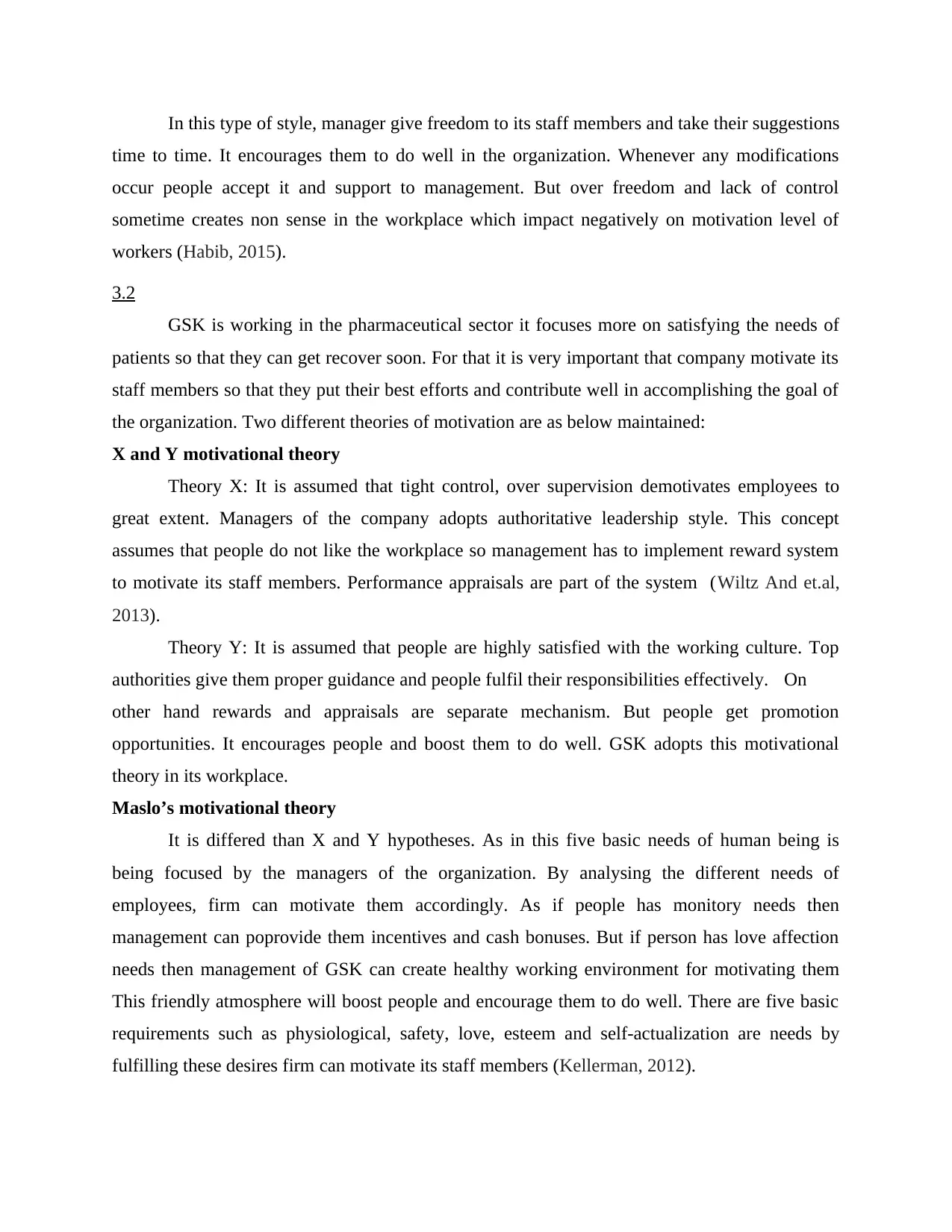
In this type of style, manager give freedom to its staff members and take their suggestions
time to time. It encourages them to do well in the organization. Whenever any modifications
occur people accept it and support to management. But over freedom and lack of control
sometime creates non sense in the workplace which impact negatively on motivation level of
workers (Habib, 2015).
3.2
GSK is working in the pharmaceutical sector it focuses more on satisfying the needs of
patients so that they can get recover soon. For that it is very important that company motivate its
staff members so that they put their best efforts and contribute well in accomplishing the goal of
the organization. Two different theories of motivation are as below maintained:
X and Y motivational theory
Theory X: It is assumed that tight control, over supervision demotivates employees to
great extent. Managers of the company adopts authoritative leadership style. This concept
assumes that people do not like the workplace so management has to implement reward system
to motivate its staff members. Performance appraisals are part of the system (Wiltz And et.al,
2013).
Theory Y: It is assumed that people are highly satisfied with the working culture. Top
authorities give them proper guidance and people fulfil their responsibilities effectively. On
other hand rewards and appraisals are separate mechanism. But people get promotion
opportunities. It encourages people and boost them to do well. GSK adopts this motivational
theory in its workplace.
Maslo’s motivational theory
It is differed than X and Y hypotheses. As in this five basic needs of human being is
being focused by the managers of the organization. By analysing the different needs of
employees, firm can motivate them accordingly. As if people has monitory needs then
management can poprovide them incentives and cash bonuses. But if person has love affection
needs then management of GSK can create healthy working environment for motivating them
This friendly atmosphere will boost people and encourage them to do well. There are five basic
requirements such as physiological, safety, love, esteem and self-actualization are needs by
fulfilling these desires firm can motivate its staff members (Kellerman, 2012).
time to time. It encourages them to do well in the organization. Whenever any modifications
occur people accept it and support to management. But over freedom and lack of control
sometime creates non sense in the workplace which impact negatively on motivation level of
workers (Habib, 2015).
3.2
GSK is working in the pharmaceutical sector it focuses more on satisfying the needs of
patients so that they can get recover soon. For that it is very important that company motivate its
staff members so that they put their best efforts and contribute well in accomplishing the goal of
the organization. Two different theories of motivation are as below maintained:
X and Y motivational theory
Theory X: It is assumed that tight control, over supervision demotivates employees to
great extent. Managers of the company adopts authoritative leadership style. This concept
assumes that people do not like the workplace so management has to implement reward system
to motivate its staff members. Performance appraisals are part of the system (Wiltz And et.al,
2013).
Theory Y: It is assumed that people are highly satisfied with the working culture. Top
authorities give them proper guidance and people fulfil their responsibilities effectively. On
other hand rewards and appraisals are separate mechanism. But people get promotion
opportunities. It encourages people and boost them to do well. GSK adopts this motivational
theory in its workplace.
Maslo’s motivational theory
It is differed than X and Y hypotheses. As in this five basic needs of human being is
being focused by the managers of the organization. By analysing the different needs of
employees, firm can motivate them accordingly. As if people has monitory needs then
management can poprovide them incentives and cash bonuses. But if person has love affection
needs then management of GSK can create healthy working environment for motivating them
This friendly atmosphere will boost people and encourage them to do well. There are five basic
requirements such as physiological, safety, love, esteem and self-actualization are needs by
fulfilling these desires firm can motivate its staff members (Kellerman, 2012).
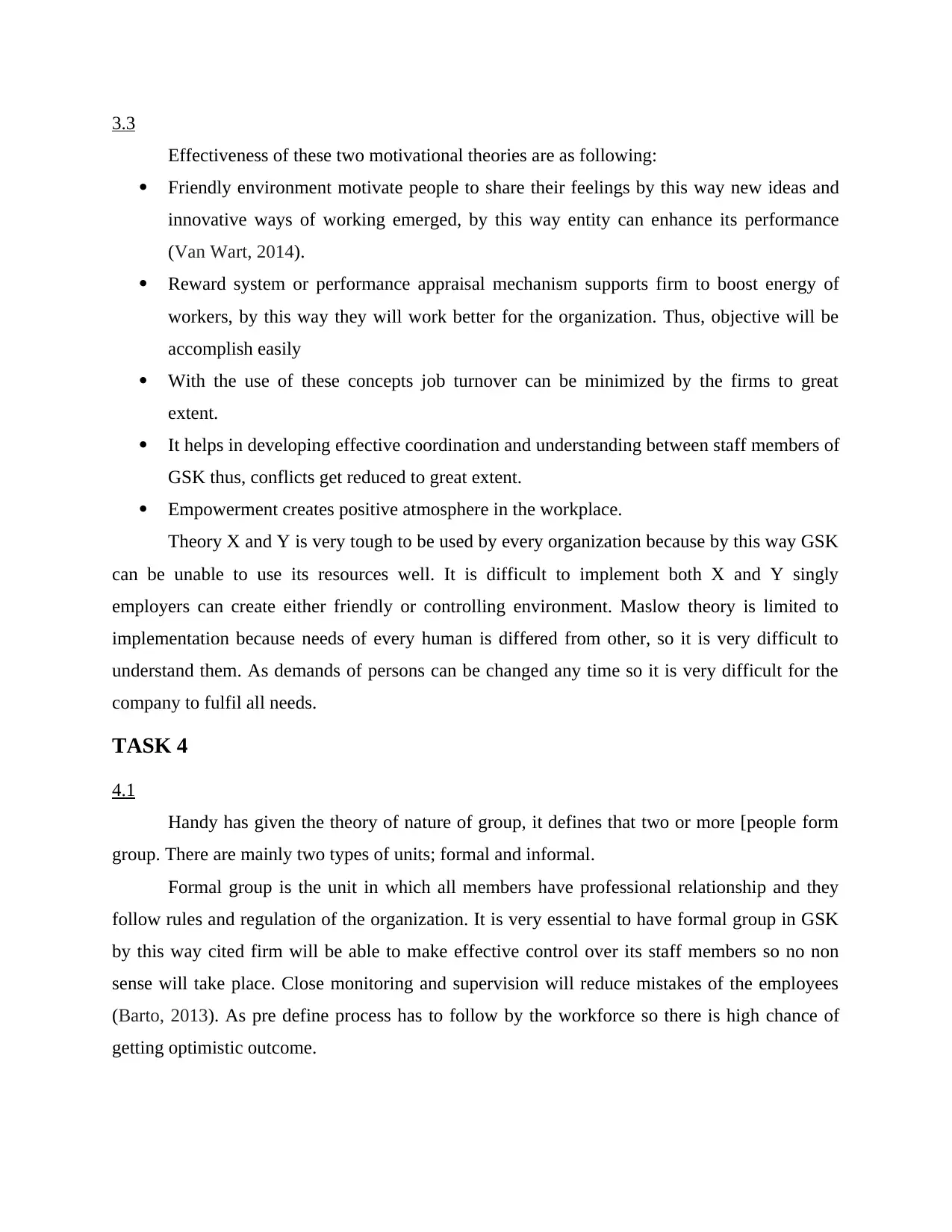
3.3
Effectiveness of these two motivational theories are as following:
Friendly environment motivate people to share their feelings by this way new ideas and
innovative ways of working emerged, by this way entity can enhance its performance
(Van Wart, 2014).
Reward system or performance appraisal mechanism supports firm to boost energy of
workers, by this way they will work better for the organization. Thus, objective will be
accomplish easily
With the use of these concepts job turnover can be minimized by the firms to great
extent.
It helps in developing effective coordination and understanding between staff members of
GSK thus, conflicts get reduced to great extent.
Empowerment creates positive atmosphere in the workplace.
Theory X and Y is very tough to be used by every organization because by this way GSK
can be unable to use its resources well. It is difficult to implement both X and Y singly
employers can create either friendly or controlling environment. Maslow theory is limited to
implementation because needs of every human is differed from other, so it is very difficult to
understand them. As demands of persons can be changed any time so it is very difficult for the
company to fulfil all needs.
TASK 4
4.1
Handy has given the theory of nature of group, it defines that two or more [people form
group. There are mainly two types of units; formal and informal.
Formal group is the unit in which all members have professional relationship and they
follow rules and regulation of the organization. It is very essential to have formal group in GSK
by this way cited firm will be able to make effective control over its staff members so no non
sense will take place. Close monitoring and supervision will reduce mistakes of the employees
(Barto, 2013). As pre define process has to follow by the workforce so there is high chance of
getting optimistic outcome.
Effectiveness of these two motivational theories are as following:
Friendly environment motivate people to share their feelings by this way new ideas and
innovative ways of working emerged, by this way entity can enhance its performance
(Van Wart, 2014).
Reward system or performance appraisal mechanism supports firm to boost energy of
workers, by this way they will work better for the organization. Thus, objective will be
accomplish easily
With the use of these concepts job turnover can be minimized by the firms to great
extent.
It helps in developing effective coordination and understanding between staff members of
GSK thus, conflicts get reduced to great extent.
Empowerment creates positive atmosphere in the workplace.
Theory X and Y is very tough to be used by every organization because by this way GSK
can be unable to use its resources well. It is difficult to implement both X and Y singly
employers can create either friendly or controlling environment. Maslow theory is limited to
implementation because needs of every human is differed from other, so it is very difficult to
understand them. As demands of persons can be changed any time so it is very difficult for the
company to fulfil all needs.
TASK 4
4.1
Handy has given the theory of nature of group, it defines that two or more [people form
group. There are mainly two types of units; formal and informal.
Formal group is the unit in which all members have professional relationship and they
follow rules and regulation of the organization. It is very essential to have formal group in GSK
by this way cited firm will be able to make effective control over its staff members so no non
sense will take place. Close monitoring and supervision will reduce mistakes of the employees
(Barto, 2013). As pre define process has to follow by the workforce so there is high chance of
getting optimistic outcome.
Secure Best Marks with AI Grader
Need help grading? Try our AI Grader for instant feedback on your assignments.
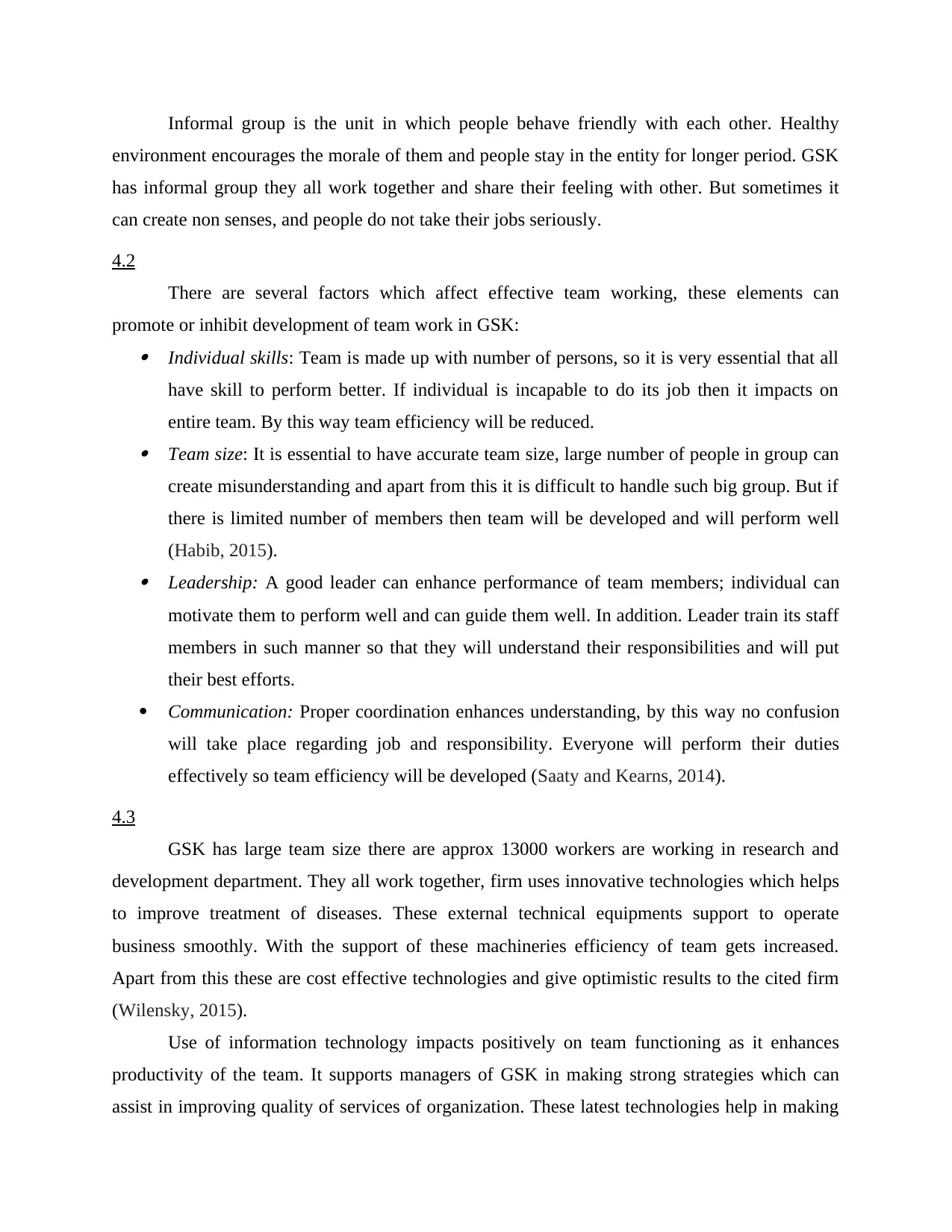
Informal group is the unit in which people behave friendly with each other. Healthy
environment encourages the morale of them and people stay in the entity for longer period. GSK
has informal group they all work together and share their feeling with other. But sometimes it
can create non senses, and people do not take their jobs seriously.
4.2
There are several factors which affect effective team working, these elements can
promote or inhibit development of team work in GSK: Individual skills: Team is made up with number of persons, so it is very essential that all
have skill to perform better. If individual is incapable to do its job then it impacts on
entire team. By this way team efficiency will be reduced. Team size: It is essential to have accurate team size, large number of people in group can
create misunderstanding and apart from this it is difficult to handle such big group. But if
there is limited number of members then team will be developed and will perform well
(Habib, 2015). Leadership: A good leader can enhance performance of team members; individual can
motivate them to perform well and can guide them well. In addition. Leader train its staff
members in such manner so that they will understand their responsibilities and will put
their best efforts.
Communication: Proper coordination enhances understanding, by this way no confusion
will take place regarding job and responsibility. Everyone will perform their duties
effectively so team efficiency will be developed (Saaty and Kearns, 2014).
4.3
GSK has large team size there are approx 13000 workers are working in research and
development department. They all work together, firm uses innovative technologies which helps
to improve treatment of diseases. These external technical equipments support to operate
business smoothly. With the support of these machineries efficiency of team gets increased.
Apart from this these are cost effective technologies and give optimistic results to the cited firm
(Wilensky, 2015).
Use of information technology impacts positively on team functioning as it enhances
productivity of the team. It supports managers of GSK in making strong strategies which can
assist in improving quality of services of organization. These latest technologies help in making
environment encourages the morale of them and people stay in the entity for longer period. GSK
has informal group they all work together and share their feeling with other. But sometimes it
can create non senses, and people do not take their jobs seriously.
4.2
There are several factors which affect effective team working, these elements can
promote or inhibit development of team work in GSK: Individual skills: Team is made up with number of persons, so it is very essential that all
have skill to perform better. If individual is incapable to do its job then it impacts on
entire team. By this way team efficiency will be reduced. Team size: It is essential to have accurate team size, large number of people in group can
create misunderstanding and apart from this it is difficult to handle such big group. But if
there is limited number of members then team will be developed and will perform well
(Habib, 2015). Leadership: A good leader can enhance performance of team members; individual can
motivate them to perform well and can guide them well. In addition. Leader train its staff
members in such manner so that they will understand their responsibilities and will put
their best efforts.
Communication: Proper coordination enhances understanding, by this way no confusion
will take place regarding job and responsibility. Everyone will perform their duties
effectively so team efficiency will be developed (Saaty and Kearns, 2014).
4.3
GSK has large team size there are approx 13000 workers are working in research and
development department. They all work together, firm uses innovative technologies which helps
to improve treatment of diseases. These external technical equipments support to operate
business smoothly. With the support of these machineries efficiency of team gets increased.
Apart from this these are cost effective technologies and give optimistic results to the cited firm
(Wilensky, 2015).
Use of information technology impacts positively on team functioning as it enhances
productivity of the team. It supports managers of GSK in making strong strategies which can
assist in improving quality of services of organization. These latest technologies help in making
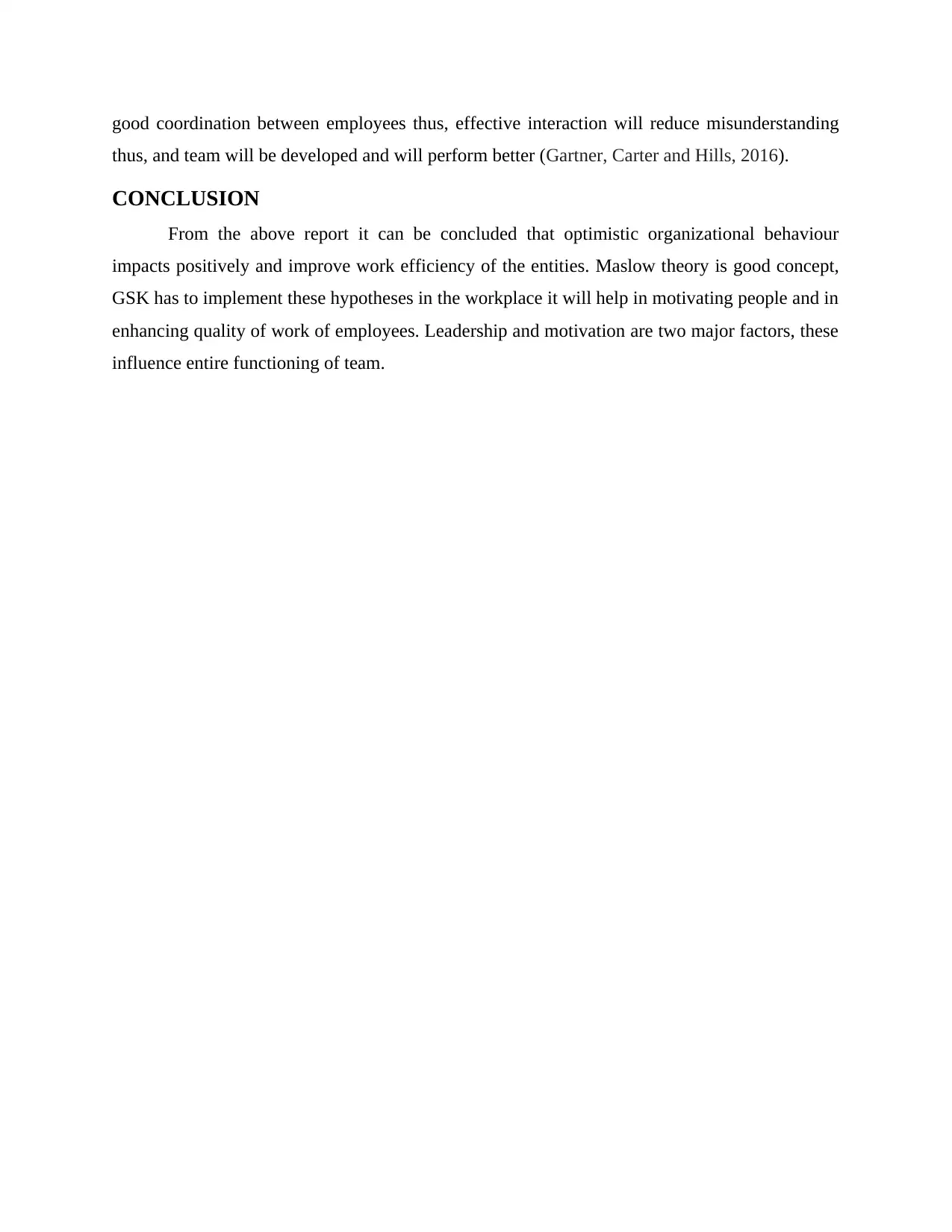
good coordination between employees thus, effective interaction will reduce misunderstanding
thus, and team will be developed and will perform better (Gartner, Carter and Hills, 2016).
CONCLUSION
From the above report it can be concluded that optimistic organizational behaviour
impacts positively and improve work efficiency of the entities. Maslow theory is good concept,
GSK has to implement these hypotheses in the workplace it will help in motivating people and in
enhancing quality of work of employees. Leadership and motivation are two major factors, these
influence entire functioning of team.
thus, and team will be developed and will perform better (Gartner, Carter and Hills, 2016).
CONCLUSION
From the above report it can be concluded that optimistic organizational behaviour
impacts positively and improve work efficiency of the entities. Maslow theory is good concept,
GSK has to implement these hypotheses in the workplace it will help in motivating people and in
enhancing quality of work of employees. Leadership and motivation are two major factors, these
influence entire functioning of team.
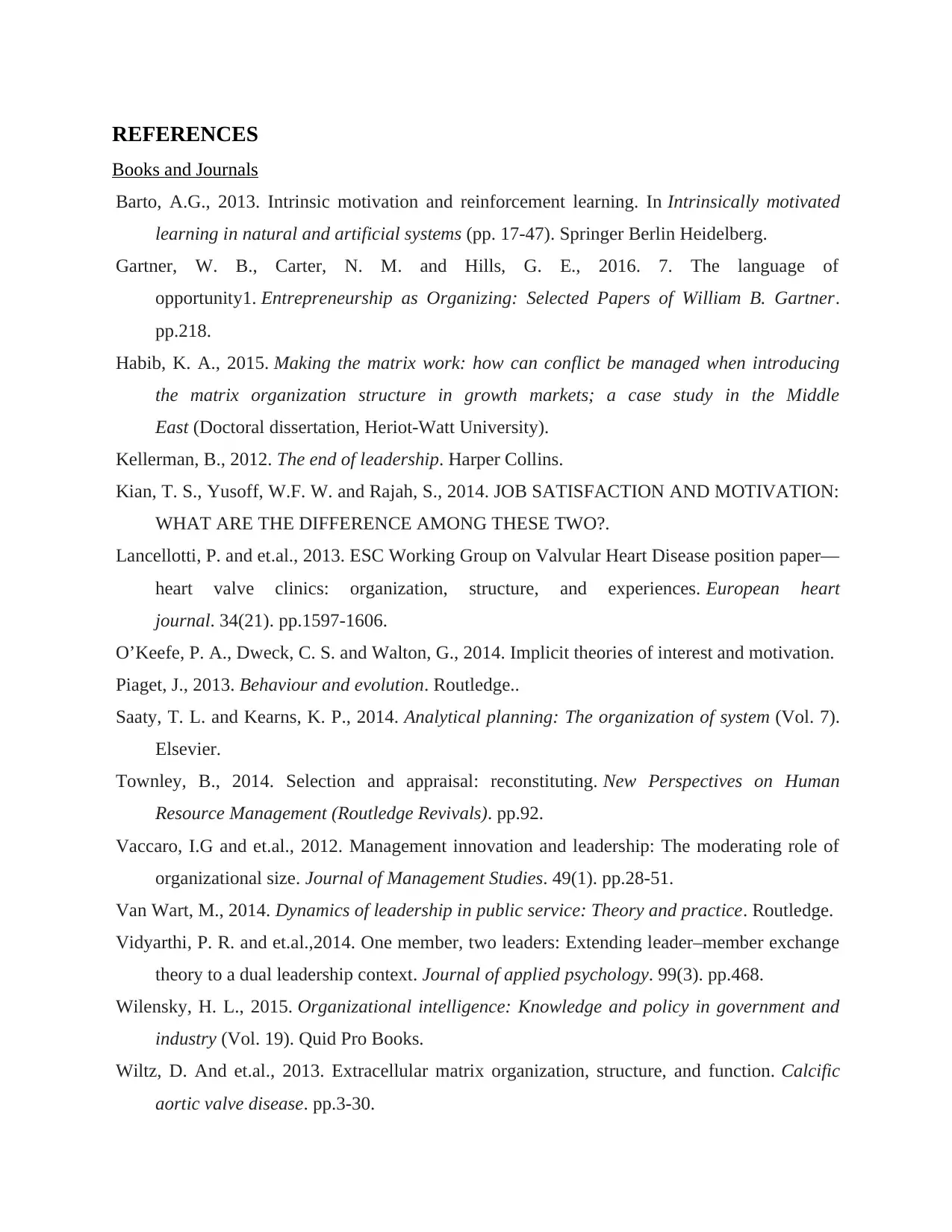
REFERENCES
Books and Journals
Barto, A.G., 2013. Intrinsic motivation and reinforcement learning. In Intrinsically motivated
learning in natural and artificial systems (pp. 17-47). Springer Berlin Heidelberg.
Gartner, W. B., Carter, N. M. and Hills, G. E., 2016. 7. The language of
opportunity1. Entrepreneurship as Organizing: Selected Papers of William B. Gartner.
pp.218.
Habib, K. A., 2015. Making the matrix work: how can conflict be managed when introducing
the matrix organization structure in growth markets; a case study in the Middle
East (Doctoral dissertation, Heriot-Watt University).
Kellerman, B., 2012. The end of leadership. Harper Collins.
Kian, T. S., Yusoff, W.F. W. and Rajah, S., 2014. JOB SATISFACTION AND MOTIVATION:
WHAT ARE THE DIFFERENCE AMONG THESE TWO?.
Lancellotti, P. and et.al., 2013. ESC Working Group on Valvular Heart Disease position paper—
heart valve clinics: organization, structure, and experiences. European heart
journal. 34(21). pp.1597-1606.
O’Keefe, P. A., Dweck, C. S. and Walton, G., 2014. Implicit theories of interest and motivation.
Piaget, J., 2013. Behaviour and evolution. Routledge..
Saaty, T. L. and Kearns, K. P., 2014. Analytical planning: The organization of system (Vol. 7).
Elsevier.
Townley, B., 2014. Selection and appraisal: reconstituting. New Perspectives on Human
Resource Management (Routledge Revivals). pp.92.
Vaccaro, I.G and et.al., 2012. Management innovation and leadership: The moderating role of
organizational size. Journal of Management Studies. 49(1). pp.28-51.
Van Wart, M., 2014. Dynamics of leadership in public service: Theory and practice. Routledge.
Vidyarthi, P. R. and et.al.,2014. One member, two leaders: Extending leader–member exchange
theory to a dual leadership context. Journal of applied psychology. 99(3). pp.468.
Wilensky, H. L., 2015. Organizational intelligence: Knowledge and policy in government and
industry (Vol. 19). Quid Pro Books.
Wiltz, D. And et.al., 2013. Extracellular matrix organization, structure, and function. Calcific
aortic valve disease. pp.3-30.
Books and Journals
Barto, A.G., 2013. Intrinsic motivation and reinforcement learning. In Intrinsically motivated
learning in natural and artificial systems (pp. 17-47). Springer Berlin Heidelberg.
Gartner, W. B., Carter, N. M. and Hills, G. E., 2016. 7. The language of
opportunity1. Entrepreneurship as Organizing: Selected Papers of William B. Gartner.
pp.218.
Habib, K. A., 2015. Making the matrix work: how can conflict be managed when introducing
the matrix organization structure in growth markets; a case study in the Middle
East (Doctoral dissertation, Heriot-Watt University).
Kellerman, B., 2012. The end of leadership. Harper Collins.
Kian, T. S., Yusoff, W.F. W. and Rajah, S., 2014. JOB SATISFACTION AND MOTIVATION:
WHAT ARE THE DIFFERENCE AMONG THESE TWO?.
Lancellotti, P. and et.al., 2013. ESC Working Group on Valvular Heart Disease position paper—
heart valve clinics: organization, structure, and experiences. European heart
journal. 34(21). pp.1597-1606.
O’Keefe, P. A., Dweck, C. S. and Walton, G., 2014. Implicit theories of interest and motivation.
Piaget, J., 2013. Behaviour and evolution. Routledge..
Saaty, T. L. and Kearns, K. P., 2014. Analytical planning: The organization of system (Vol. 7).
Elsevier.
Townley, B., 2014. Selection and appraisal: reconstituting. New Perspectives on Human
Resource Management (Routledge Revivals). pp.92.
Vaccaro, I.G and et.al., 2012. Management innovation and leadership: The moderating role of
organizational size. Journal of Management Studies. 49(1). pp.28-51.
Van Wart, M., 2014. Dynamics of leadership in public service: Theory and practice. Routledge.
Vidyarthi, P. R. and et.al.,2014. One member, two leaders: Extending leader–member exchange
theory to a dual leadership context. Journal of applied psychology. 99(3). pp.468.
Wilensky, H. L., 2015. Organizational intelligence: Knowledge and policy in government and
industry (Vol. 19). Quid Pro Books.
Wiltz, D. And et.al., 2013. Extracellular matrix organization, structure, and function. Calcific
aortic valve disease. pp.3-30.
Paraphrase This Document
Need a fresh take? Get an instant paraphrase of this document with our AI Paraphraser

1 out of 14
Related Documents
Your All-in-One AI-Powered Toolkit for Academic Success.
+13062052269
info@desklib.com
Available 24*7 on WhatsApp / Email
![[object Object]](/_next/static/media/star-bottom.7253800d.svg)
Unlock your academic potential
© 2024 | Zucol Services PVT LTD | All rights reserved.





